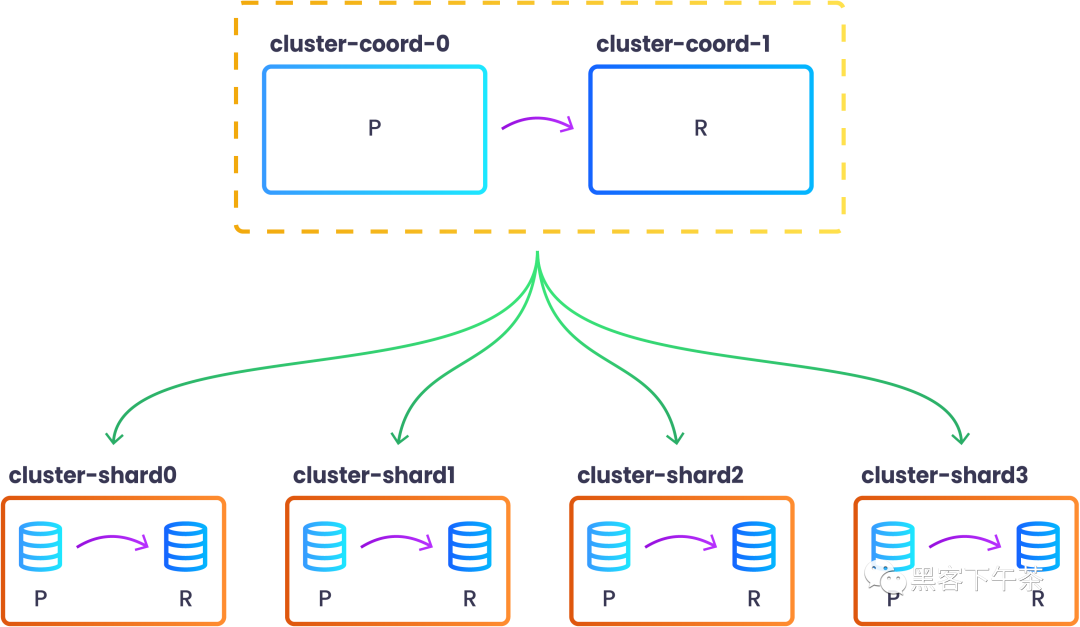StackGres 資料庫平臺工程,使用 Citus + Patroni 建立生產級高可用分散式 PostgreSQL 分片叢集

系列
- StackGres, 可私有部署的雲原生資料庫平臺工程
- StackGres 資料庫平臺工程功能介紹與快速上手
- StackGres 1.6 資料庫平臺工程叢集設定管理(K8S Pods/PostgreSQL/PgBouncer)
- StackGres 1.6 資料庫平臺工程,叢集高可用(Patroni 3 管理)
什麼是 Sharded Cluster(分片叢集)
Sharded Cluster(分片叢集)是實現資料庫分片的叢集。資料庫分片是跨多臺機器儲存大型資料庫的過程。這是通過在多個 Postgres 主範例之間分隔錶行來實現的。這種方法提供了將資料庫擴充套件到多個範例的能力,既有利於讀取和寫入吞吐量,也有利於在不同範例之間分離資料以實現安全性和/或滿足法規或合規性要求。
Sharded Cluster 是如何實現的
一個分片叢集是通過構造一個稱為協調器的 SGCluster 和一個或多個稱為 shards(分片) 的 SGCluster 來實現的。顧名思義,協調器協調實際儲存資料的 shards(分片) 。StackGres 負責按照 SGShardedCluster 中設定的規範建立相關的 SGCluster。
SGShardedCluster 可以定義分片的型別(即所使用的內部分片實現)和要分片的資料庫。
目前只有一個實現可用,這是通過使用 Citus 擴充套件提供的。
建立一個基本的 Citus Sharded Cluster
建立 SGShardedCluster 資源:
cat << EOF | kubectl apply -f -
apiVersion: stackgres.io/v1alpha1
kind: SGShardedCluster
metadata:
name: cluster
spec:
type: citus
database: mydatabase
postgres:
version: '15'
coordinator:
instances: 2
pods:
persistentVolume:
size: '10Gi'
shards:
clusters: 4
instancesPerCluster: 2
pods:
persistentVolume:
size: '10Gi'
EOF
此設定將建立一個包含 2 個 pod 的 coordinator(協調器)和4 個 shards(分片),每個分片包含 2 個 pod。
所有 Pod 就緒後,您可以通過發出以下命令來檢視新建立的分片叢集的拓撲:
kubectl exec -n my-cluster cluster-coord-0 -c patroni -- patronictl list
+ Citus cluster: cluster --+------------------+--------------+---------+----+-----------+
| Group | Member | Host | Role | State | TL | Lag in MB |
+-------+------------------+------------------+--------------+---------+----+-----------+
| 0 | cluster-coord-0 | 10.244.0.16:7433 | Leader | running | 1 | |
| 0 | cluster-coord-1 | 10.244.0.34:7433 | Sync Standby | running | 1 | 0 |
| 1 | cluster-shard0-0 | 10.244.0.19:7433 | Leader | running | 1 | |
| 1 | cluster-shard0-1 | 10.244.0.48:7433 | Replica | running | 1 | 0 |
| 2 | cluster-shard1-0 | 10.244.0.20:7433 | Leader | running | 1 | |
| 2 | cluster-shard1-1 | 10.244.0.42:7433 | Replica | running | 1 | 0 |
| 3 | cluster-shard2-0 | 10.244.0.22:7433 | Leader | running | 1 | |
| 3 | cluster-shard2-1 | 10.244.0.43:7433 | Replica | running | 1 | 0 |
| 4 | cluster-shard3-0 | 10.244.0.27:7433 | Leader | running | 1 | |
| 4 | cluster-shard3-1 | 10.244.0.45:7433 | Replica | running | 1 | 0 |
+-------+------------------+------------------+--------------+---------+----+-----------+
請注意,pg_dist_node 表的 groupid 列與上面的 Patroni Group 列相同。特別是,識別符號為 0 的組是 coordinator(協調器) 組(coordinator 的 shouldhaveshards 列設定為 f)。
建立一個自定義的生產級 Citus Sharded Cluster
Sharded Cluster 自定義設定
有關分片叢集設定的更多詳細資訊,請參閱自定義你的 Postgres Cluster一節。具體來說,您將在 my-cluster 名稱空間中建立以下自定義資源:
SGInstanceProfile(k8s pods 自定義設定)
- 一個名為
size-small的 SGInstanceProfileapiVersion: stackgres.io/v1 kind: SGInstanceProfile metadata: namespace: demo name: size-small spec: cpu: "4" memory: "8Gi"
SGPostgresConfig(postgres 自定義設定)
- 一個名為
pgconfig1的 SGPostgresConfigapiVersion: stackgres.io/v1 kind: SGPostgresConfig metadata: name: postgresconf spec: postgresVersion: "11" postgresql.conf: password_encryption: 'scram-sha-256' random_page_cost: '1.5' shared_buffers: '256MB' wal_compression: 'on'
SGPoolingConfig(pgBouncer 自定義設定)
- 一個名為
poolconfig1SGPoolingConfigapiVersion: stackgres.io/v1 kind: SGPoolingConfig metadata: name: pgbouncerconf spec: pgBouncer: pgbouncer.ini: pgbouncer: max_client_conn: '2000' default_pool_size: '50' databases: foodb: max_db_connections: 1000 pool_size: 20 dbname: 'bardb' reserve_pool: 5 users: user1: pool_mode: transaction max_user_connections: 50 user2: pool_mode: session max_user_connections: '100'
SGObjectStorage(s3 資料備份自定義設定)
- 一個名為
backupconfig1的 SGObjectStorageapiVersion: stackgres.io/v1beta1 kind: SGObjectStorage metadata: name: objectstorage spec: type: s3Compatible s3Compatible: bucket: stackgres region: k8s enablePathStyleAddressing: true endpoint: http://my-cluster-minio:9000 awsCredentials: secretKeySelectors: accessKeyId: key: accesskey name: my-cluster-minio secretAccessKey: key: secretkey name: my-cluster-minio
SGDistributedLogs(分散式紀錄檔 server 設定)
- 一個名為
distributedlogs的 SGDistributedLogsapiVersion: stackgres.io/v1 kind: SGDistributedLogs metadata: name: distributedlogs spec: persistentVolume: size: 10Gi
設定 SQL 啟動指令碼
最後但同樣重要的是,StackGres 允許您包含幾個 managedSql 指令碼,以便在啟動時執行叢集操作。
在這個例子中,我們使用 Kubernetes secret 建立一個 Postgres 使用者,並使用 Citus 建立一個分片表:
kubectl -n my-cluster create secret generic pgbench-user-password-secret \
--from-literal=pgbench-create-user-sql="create user pgbench password 'admin123'"
然後我們在 SGScript 中參照這個 secret:
cat << EOF | kubectl apply -f -
apiVersion: stackgres.io/v1
kind: SGScript
metadata:
namespace: my-cluster
name: cluster-scripts
spec:
scripts:
- name: create-pgbench-user
scriptFrom:
secretKeyRef:
name: pgbench-user-password-secret
key: pgbench-create-user-sql
- name: create-pgbench-tables
database: mydatabase
user: pgbench
script: |
CREATE TABLE pgbench_accounts (
aid integer NOT NULL,
bid integer,
abalance integer,
filler character(84)
);
- name: distribute-pgbench-tables
database: mydatabase
user: pgbench
script: |
SELECT create_distributed_table('pgbench_history', 'aid');
EOF
指令碼由之前建立的 Secret 和內聯的 SQL 指令定義。
SGScript 將在分片叢集的協調器的 managedSql 定義中被參照,如下所示。
請注意,我們同樣可以在設定對映中定義 SQL 指令碼,但是,由於 password 表示憑據,因此我們使用的是 secret。
建立 Citus 叢集
執行了所有必要的步驟來建立我們的 StackGres 叢集。
建立 SGShardedCluster 資源:
cat << EOF | kubectl apply -f -
apiVersion: stackgres.io/v1alpha1
kind: SGShardedCluster
metadata:
namespace: my-cluster
name: cluster
spec:
type: citus
database: mydatabase
postgres:
version: '15.3'
coordinator:
instances: 2
sgInstanceProfile: 'size-small'
pods:
persistentVolume:
size: '10Gi'
configurations:
sgPostgresConfig: 'pgconfig1'
sgPoolingConfig: 'poolconfig1'
managedSql:
scripts:
- sgScript: cluster-scripts
shards:
clusters: 3
instancesPerCluster: 2
sgInstanceProfile: 'size-small'
pods:
persistentVolume:
size: '10Gi'
configurations:
sgPostgresConfig: 'pgconfig1'
sgPoolingConfig: 'poolconfig1'
configurations:
backups:
- sgObjectStorage: 'backupconfig1'
cronSchedule: '*/5 * * * *'
retention: 6
distributedLogs:
sgDistributedLogs: 'distributedlogs'
prometheusAutobind: true
EOF
注意,每個資源都有自己的 name,並在 StackGres 分片叢集定義中被參照。
建立 CR 的順序與成功建立分片叢集相關,即在建立依賴資源之前建立所有必要的 resources、secrets 和 permissions。
另一個有用的設定是 prometheusAutobind: true 定義。
此引數自動啟用對分片叢集的監控。
如果我們已經在 Kubernetes 環境中安裝了 Prometheus operator。